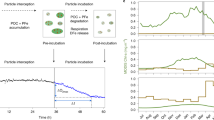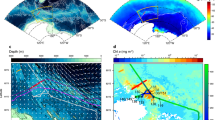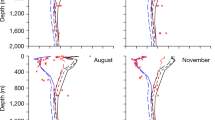Abstract
Iron supply has a key role in stimulating phytoplankton blooms in high-nitrate low-chlorophyll oceanic waters1,2,3,4,5. However, the fate of the carbon fixed by these blooms, and how efficiently it is exported into the ocean's interior, remains largely unknown1,2,3,4,5. Here we report on the decline and fate of an iron-stimulated diatom bloom in the Gulf of Alaska. The bloom terminated on day 18, following the depletion of iron and then silicic acid, after which mixed-layer particulate organic carbon (POC) concentrations declined over six days. Increased particulate silica export via sinking diatoms was recorded in sediment traps at depths between 50 and 125 m from day 21, yet increased POC export was not evident until day 24. Only a small proportion of the mixed-layer POC was intercepted by the traps, with more than half of the mixed-layer POC deficit attributable to bacterial remineralization and mesozooplankton grazing. The depletion of silicic acid and the inefficient transfer of iron-increased POC below the permanent thermocline have major implications both for the biogeochemical interpretation of times of greater iron supply in the geological past6,7, and also for proposed geo-engineering schemes to increase oceanic carbon sequestration3,8.
This is a preview of subscription content, access via your institution
Access options
Subscribe to this journal
Receive 51 print issues and online access
$199.00 per year
only $3.90 per issue
Buy this article
- Purchase on Springer Link
- Instant access to full article PDF
Prices may be subject to local taxes which are calculated during checkout


Similar content being viewed by others
References
Coale, K. H. et al. A massive phytoplankton bloom induced by an ecosystem-scale iron fertilization experiment in the equatorial Pacific Ocean. Nature 383, 495–501 (1996)
Boyd, P. W. et al. A mesoscale phytoplankton bloom in the polar Southern Ocean stimulated by iron fertilization. Nature 407, 695–702 (2000)
Buesseler, K. O. & Boyd, P. W. Will ocean fertilization work? Science 300, 67–68 (2003)
Gervais, F., Riebesell, U. & Gorbunov, M. Y. Changes in primary productivity and chlorophyll a in response to iron fertilization in the Southern Polar Frontal Zone. Limnol. Oceanogr. 47, 1324–1335 (2002)
Tsuda, A. et al. A mesoscale iron enrichment in the western Subarctic Pacific induces a large centric diatom bloom. Science 300, 958–961 (2003)
Martin, J. H. Glacial-interglacial CO2 change: The iron hypothesis. Paleoceanography 5, 1–13 (1990)
Matsumoto, K., Sarmiento, J. L. & Brzezinski, M. A. Silicic acid leakage from the Southern Ocean: A possible explanation for glacial atmospheric pCO2 . Glob. Biogeochem. Cycles 16, doi:10.1029/2001GB001442 (2002)
Chisholm, S. W., Falkowski, P. G. & Cullen, J. J. Oceans—Discrediting ocean fertilization. Science 294, 309–310 (2001)
Petit, J. R. et al. Climate and atmospheric history of the past 420,000 years from the Vostok ice core, Antarctica. Nature 399, 429–436 (1999)
Tabata, S. The general circulation of the Pacific Ocean and a brief account of the oceanographic structure of the North Pacific Ocean. Part I—Circulation and volume transports. Atmosphere 13, 133–168 (1975)
Nishioka, J., Takeda, S., Wong, C. S. & Johnson, W. K. Size-fractionated iron concentrations in the northeast Pacific Ocean: distribution of soluble and small colloidal iron. Mar. Chem. 74, 157–179 (2001)
LaRoche, J., Boyd, P. W., McKay, R. M. L. & Geider, R. J. Flavodoxin as an in situ marker for iron stress in phytoplankton. Nature 382, 802–805 (1996)
Cullen, J. J. Hypothesis to explain high-nutrient conditions in the open sea. Limnol. Oceanogr. 36, 1578–1599 (1991)
Strathmann, R. R. Estimating the organic carbon content of phytoplankton from cell volume or plasma volume. Limnol. Oceanogr. 12, 411–418 (1967)
Komar, P. D., Morse, A. P., Small, L. F. & Fowler, S. W. An analysis of sinking rates of natural copepod and euphausiid fecal pellets. Limnol. Oceanogr. 26, 172–180 (1981)
Bidle, K. D., Manganelli, M. & Azam, F. Regulation of oceanic silicon and carbon preservation by temperature control on bacteria. Science 298, 1980–1984 (2002)
Smith, D. C., Simon, M., Alldredge, A. L. & Azam, F. Intense hydrolytic enzyme activity on marine aggregates and implications for rapid particle dissolution. Nature 359, 139–142 (1992)
Dagg, M. Sinking particles as a possible source of nutrition for the large calanoid copepod Neocalanus cristatus in the sub-arctic Pacific Ocean. Deep-Sea Res. I 40, 1431–1445 (1993)
Buesseler, K. O., Michaels, A. F., Siegel, D. A. & Knap, A. H. A 3-dimensional time-dependent approach to calibrating sediment trap fluxes. Glob. Biogeochem. Cycles 8, 179–193 (1994)
Treguer, P. et al. The silica balance in the world ocean: a re-estimate. Science 268, 375–379 (1995)
Sunda, W. G. & Huntsman, S. A. Iron uptake and growth limitation in oceanic and coastal phytoplankton. Mar. Chem. 50, 189–206 (1995)
Buesseler, K. O. The decoupling of production and particulate export in the surface ocean. Glob. Biogeochem. Cycles 12, 297–310 (1998)
Harrison, K. G. Role of increased marine silica input on paleo-pCO2 levels. Paleoceanography 15, 292–298 (2000)
Law, C. S., Abraham, E. R., Watson, A. J. & Liddicoat, M. Vertical diffusion and nutrient supply to the surface mixed layer of the Antarctic Circumpolar Current. J. Geophys. Res. 108, doi:10.1029/2002JC001604 (2003)
Abraham, E. R. et al. Importance of stirring in the development of an iron-fertilized phytoplankton bloom. Nature 407, 727–730 (2000)
Honda, M. C. et al. The biological pump in the northwestern North Pacific based on fluxes and major components of particulate matter obtained by sediment-trap experiments (1997–2000). Deep-Sea Res. II 49, 5595–5625 (2002)
Bishop, J. K. B. Transmissiometer measurement of POC. Deep-Sea Res. I 46, 353–369 (1999)
Tsuda, A. & Sugisaki, H. In-situ grazing rate of the copepod population in the western subarctic North Pacific during spring. Mar. Biol. 120, 203–210 (1994)
Rivkin, R. & Legendre, L. Biogenic carbon cycling in the upper ocean: effects of microbial respiration. Science 291, 2398–2400 (2001)
Siegel, D. A., Granata, T. C., Michaels, A. F. & Dickey, T. D. Mesoscale eddy diffusion, particle sinking, and the interpretation of sediment trap data. J. Geophys. Res. 95, 5305–5311 (1990)
Acknowledgements
We thank the officers and crews and scientists on board the John P. Tully, El Puma and Kaiyo Maru. We are grateful to S. Toews for shoreside logistical support. The manuscript was improved by comments from K. Currie, R. Frew, C. Hurd, P. Boyd, D. Hutchins and T. Trull. This study was supported by NSERC Canada as part of the C-SOLAS programme, CFCAS, DFO PERD (Canada), the New Zealand PGSF (Ocean Ecosystems), and the Global Environmental Research Fund from the Ministry of Environment, the Fisheries Agency, and the Central Research Institute of Electric Power Industry research funding (Japan).
Author information
Authors and Affiliations
Corresponding author
Ethics declarations
Competing interests
The authors declare that they have no competing financial interests.
Supplementary information
Supplementary Figures
Supplementary figure 1: A) An fCO2 contour plot (µatm) of the patch on day 18; B) Algal photosynthetic competence (Fv/Fm, mean mixed-layer values) in the mixed-layer for IN and OUT waters; Supplementary Figure 2: SeaWiFS Ocean Colour images on day 19 and day 24 showing the rapid decline of the bloom; Supplementary Figure 3: Density profiles for IN patch from days 16-25. (PPT 194 kb)
Rights and permissions
About this article
Cite this article
Boyd, P., Law, C., Wong, C. et al. The decline and fate of an iron-induced subarctic phytoplankton bloom. Nature 428, 549–553 (2004). https://doi.org/10.1038/nature02437
Received:
Accepted:
Published:
Issue Date:
DOI: https://doi.org/10.1038/nature02437
This article is cited by
-
Potential use of engineered nanoparticles in ocean fertilization for large-scale atmospheric carbon dioxide removal
Nature Nanotechnology (2022)
-
Observations of anticyclonic eddies in the western subarctic North Pacific
Journal of Oceanography (2021)
-
A review: iron and nutrient supply in the subarctic Pacific and its impact on phytoplankton production
Journal of Oceanography (2021)
-
Particle-Size Variability of Aerosol Iron and Impact on Iron Solubility and Dry Deposition Fluxes to the Arctic Ocean
Scientific Reports (2019)
-
Iron-Stimulated Phytoplankton Blooms in the Southern Ocean: a Brief Review
Remote Sensing in Earth Systems Sciences (2019)
Comments
By submitting a comment you agree to abide by our Terms and Community Guidelines. If you find something abusive or that does not comply with our terms or guidelines please flag it as inappropriate.



